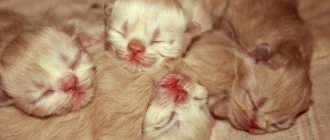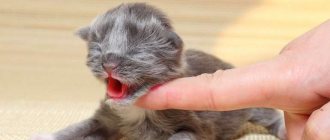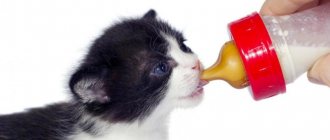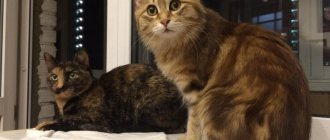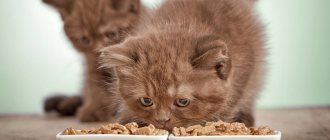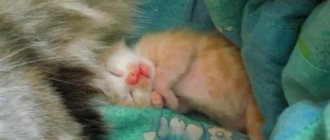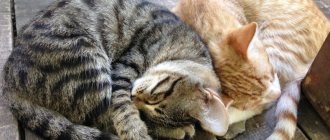Feeding a newborn kitten is a rather complex and difficult process. The reason is that he is just beginning to master unfamiliar food, and perhaps he will not like some food at all.
To correctly determine whether a kitten is full or not, pay attention to its behavior: a hungry cub squeaks all the time, crawls around its mother, or sucks the finger extended to it, while the well-fed ones suck the cat’s milk or sleep.
- What to feed a kitten for 3 weeks?
What to feed a kitten for 3 weeks?
A hungry kitten needs to be fed, and motherless babies also need feeding.
When do kittens need artificial feeding?
The ideal situation is as follows: the cat cares for and feeds the kitten until it is approximately 8 weeks old. Only then can you separate the baby from his mother. But there are times when human intervention and help is required. Reasons why this may happen include:
- death of a cat;
- lack or deficiency of milk in her;
- mastitis and inflammation of the uterus in a cat;
- eclampsia in a cat, that is, calcium deficiency;
- psycho-emotional deviations of the animal.
Sometimes the mother feeds the kittens regularly, but the babies still need complementary foods. This situation may arise if the litter is very large. It happens that a weak kitten is born, which quickly gets tired when sucking - in this case, it also needs additional nutrition. How you manage to feed a kitten without a cat or simply intervene a little in the process will determine its future health.
Ready-made feed
If the owner has chosen to eat ready-made food, it is necessary to decide on the manufacturer.
Ready-made food is purchased at a pharmacy or pet store. Preference is given to premium class. When choosing, take into account expiration date, composition, weight and age restrictions.
Some manufacturers make specialized foods designed for specific breeds. Such products take into account the individual characteristics of the jaw structure and the presence of a predisposition to diseases. Ready-made holistic feeds are considered the most optimal. This is a class of finished products that differs in its composition: only natural meat, fruits and vegetables are used, and the manufacturer does not add preservatives or dyes.
You should not give your kitten food intended for an adult. In most lines of finished products there is a distinction by age.
pros
The advantage of feeding ready-made food is that the owner does not need to calculate the pet's nutritional needs. The manufacturer, based on age, weight, breed and even temperament, adds certain nutrients to the product in the correct ratio.
In addition, such food is convenient when transporting your pet or traveling. Another advantage of store-bought food is that it saves time and effort spent on cooking.
Minuses
Cheap food, as a rule, does not meet the requirements of kittens and adults, since they contain insufficient nutrients. In addition, unscrupulous manufacturers add dyes, flavor enhancers and other chemical compounds to products that can cause an allergic reaction, poisoning and diseases of the digestive tract in the pet.
Happy Cat Junior
Belongs to the holistic class. The food is intended for babies aged from one month to one year. The products include fresh dietary meat, salmon, as well as vegetables and fruits. In addition, the manufacturer also takes into account the consistency of the food so that the kittens can eat without difficulty.
1st Choice
The product belongs to the super-premium class - lower than holistic ones. Among the advantages are lower cost and the use of natural products. A special feature of the food is the addition of salmon fat, which contains essential lipids involved in many life processes, including brain activity. The disadvantage is the small range of feeds.
Purina ProPlan
Ready-made dry food intended for kittens aged one and a half months to a year, as well as wet food for pets up to one year. The line belongs to the premium class. The main advantages are reasonable price, wide distribution in stores, high-quality composition. The disadvantage is the presence of vegetable fats and the possibility of an allergic reaction to the components.
Cat milk replacers
If the circumstances are not the best and the kitten is left without a mother, the ideal option would be to find a wet-nurse cat. If this is not possible, some alternative to cat milk will come to the rescue - its substitute. Feeding a newborn kitten is not as difficult as it seems at first glance.
Special mixtures from veterinary pharmacy
There are no organic substitutes for cat milk in nature. But today, some pet food manufacturers have created special mixtures - artificial substitutes for cat milk. They are as close as possible to the natural composition and are optimally balanced for kittens. The mixtures include many components useful for the growth and development of small pets:
- vitamins;
- minerals;
- microelements;
- Omega-3 and Omega-6 fatty acids;
- taurine
The veterinary formula is ideal for raising kittens until they are able to eat solid food on their own.
Recipes for DIY mixtures
If the price of a special mixture is too high or it is not sold in your locality, you can make it yourself - several recipes are offered.
Milk and flour
You will need 250 grams of condensed milk: always natural and twenty percent. You need to dilute it with a liter of water and add about a teaspoon of bone meal. Strain, heat and feed to babies. The mixture can be stored for no more than a day, so it is recommended to prepare it in smaller quantities. The main thing is to maintain the proportion 1:4.
With goat milk
A tablespoon of five percent glucose is mixed with goat milk, of which you will need about 1.5 tablespoons. Next, you need to add one gram of various vitamins (purchased at a veterinary pharmacy) and a teaspoon of milk powder.
Vitamin
Five percent glucose is mixed with one hundred milliliters of milk and an yolk mixed with half a tablespoon of vegetable oil is added. In the mixture you need to add Nutrilon milk baby food and a few drops of Tetravit.
Egg
A teaspoon of vegetable oil is mixed with the yolk and drops of vitamins in a proportion similar to the previous recipe.
Regardless of the composition, it is necessary to keep cat formulas in the refrigerator, and when serving, heat them to a temperature of 37 ° C. Veterinarians advise preparing complementary foods more often so that they are always fresh.
Why you shouldn't give cow's milk
When asked whether it is possible to feed a newborn kitten with cow's milk, veterinarians answer unequivocally in the negative. The composition of cat milk is very different from the milk of other animals - the amount of fat, protein and lactose varies greatly. Even adult cats do not digest goat's and cow's milk well, with their high content of lactose and fat, let alone kittens.
If you ignore the advice of veterinarians and scientifically proven facts, you can harm the baby’s health. Allergies, diarrhea, lack of essential nutrients, developmental delays - this is not a complete list of problems that can arise in a small animal when fed cow's milk. Take care of your baby's health and use special mixtures.
First feeding
What should be the first food for a three-week-old kitten? If the baby was fed by his mother, it is better to use natural products as complementary foods:
- Whole goat or cow's milk.
- Low-fat broth (beef, rabbit, turkey).
- Boiled minced meat mixed with broth and homemade meat pate.
If you fed your baby artificially, it is better to use ready-made foods as the first complementary foods:
- Grind with a blender, semi-moist food, diluted with low-fat broth.
- In case of growth retardation - pate for emaciated kittens.
Tip: If the kitten is not at all interested or does not eat solid food well, try warming the food a little before serving. Many kittens instinctively consider cold food inedible.
How to feed a small kitten: features and rules
There are certain rules and nuances of feeding a kitten. This applies to both the feeding regimen and procedures after it.
What things will you need?
To feed a kitten, you will have to purchase some items. A bottle with a special nipple will be more convenient for you and better for the animal: such a thing is sold in a veterinary pharmacy. It has an anatomically correct shape and resembles a cat's nipples.
You can feed newborn kittens without a cat either with a pipette or with a syringe without a needle. But this option is undesirable, since during feeding, air may enter the esophagus or milk may enter the respiratory tract, causing the animal to choke or regurgitate. It is very important to wash and sterilize items after each feeding.
Stages of the procedure
When everything you need has been collected and sterilized, dilute the mixture according to the instructions and heat it. It is not recommended to do this in the microwave - the mixture may warm up unevenly - it is better to heat it in a water bath.
Check your pet's body temperature. If the paws are cold, the kitten is cold, which means the food will be digested much worse. The baby must be kept warm at all times. To do this, place a heating pad wrapped in a towel or a bottle of hot water in his box or house.
When you are sure that the kitten is warm, you can proceed directly to the feeding process. To do this, lay a towel on your knees, carefully lay the kitten on its stomach and lift its head a little - this is the position in which kittens feed from their mother. For the very first time, you should moisten the nipple's spout with milk so that the baby smells the food and begins to eat.
How to determine if a kitten is full
Both conditions are extremely undesirable and even dangerous for a baby: underfeeding and overfeeding. If he doesn't get enough food, he doesn't gain weight well and appears lethargic. Overeating is indicated by loose stools in yellow, green and gray shades. You can visually determine whether the kitten is full in the following way: extend your finger to it. If the animal begins to suck, then it is not full.
The baby’s behavior is also an indicator. If the kitten is full, he simply turns away and falls asleep, sometimes milk bubbles come out of his mouth, if not, he squeaks, crawls and looks for a pacifier.
What to do after feeding
During the process, try your best to ensure that the animals are calmed by your voice. Talk to them and be sure to pet them, and after feeding, wipe off any remaining food from their faces.
At the end of feeding, lightly press the kitten's back against your stomach and gently stroke its tummy. With these actions you stimulate belching and start the process of digesting food.
To prevent kittens from suffering from constipation, it is necessary to massage their anus. This is done with cotton pads or ear swabs, which are dipped in Vaseline.
Artificial stimulation of peristalsis does not always help, and babies experience stool retention. In this case, you need to give an enema, but it is better to do this under the supervision of a veterinarian - leave the procedure to him for the first time, later you will learn how to give enemas to kittens yourself.
After feeding
After eating, small kittens, like infants, have the habit of burping. Therefore, after the feeding process is completed, before starting the massage, the babies need to be placed on their tummy and gently stroked on the back until they burp.
If the kitten cannot burp, you need to keep its face straight and motionless. If this measure does not produce results, it is worth trying to feed the baby again; perhaps he did not receive his food allowance.
How often should you feed
It is imperative to follow the regime and monitor the portions of the mixture. For the first two weeks, you will have to feed the kitten every 2 hours, even at night. Then the intervals are gradually shortened. After five weeks, the kitten can easily survive without food for 3-4 hours, and at night one feeding is enough for him.
At 6 weeks of age, babies feed on their own: they need to be fed up to 5 times a day and only during the daytime. Kittens grow very quickly, so the nursing period will not seem very long.
How to make your own mixtures
If it is not possible to buy ready-made mixtures, you can prepare them at home yourself.
The main thing is to follow the recipe.
- “Universal” mixture:
- 20% condensed milk diluted 1:5,
- bone meal (1 tsp per 1 liter of milk).
- Mix “Kitten”
- cow's or goat's milk – 25 g
- glucose 5% (20 ml)
- powdered milk – 5 g
- vitamin supplements - 1g.
- “Vitamin” mixture - recommended for weakened and sick kittens
- milk (100 ml)
- glucose 5% (20 ml)
- 1 yolk
- vegetable oil (1/2 teaspoon)
- Tetravit (about 0.3 ml)
- 2 teaspoons of infant formula “Nutrilon fermented milk”.
- “Egg” mixture:
- cow's milk – 200 ml,
- vegetable oil – 1 tsp. spoon,
- egg yolks – 2 pcs.,
- vitamins in drops (tetravit or trivit).
The ingredients of the mixtures must be mixed thoroughly and brought to a homogeneous mass.
Before feeding, the mixture is heated to 38 degrees.
The finished mixture should be stored in the refrigerator for no more than a day.
Calculation of daily portions
In the natural environment, a cat does not control the amount of milk her kittens eat. But since the task is to feed a kitten without a cat, certain standards must be observed. The baby quickly gains weight, but his stomach volume is very small, so feeding should be dosed. The daily intake of the mixture depends on the age of the baby. Below is the amount calculated per 100 g of animal body weight:
- from birth to day 5 – 30 ml;
- from 6 to 14 days – 38 ml;
- from 15 to 24 days – 45 ml;
- from the 25th day and over the next month - 55 ml.
These are recommended figures and may vary slightly for each breed. The daily volume must be divided by the number of feedings. The most preferable option, as for humans, is in small portions, but more often.
How to determine age, make a nest
The age of kittens is determined by several criteria:
- in the first three days a fresh umbilical cord is detected, later it falls off on its own;
- eyes open one and a half to two weeks after birth;
- the reaction to sounds appears from the fifth day, in addition, age can be calculated by the state of the ears - they are pressed to the surface of the head until the ear canal opens, then straightening occurs;
- by the third day of life, the baby weighs on average 100 g, after a week the weight gain is approximately 50 g, at the age of one month the baby’s body weight is 250 g;
- milk teeth appear in two-week-old kittens - the incisors grow first, then the fangs at the fourth week, all milk teeth appear by 4 months.
To create a cozy nest for kittens, you can use a small cardboard box. Since pets at an early age have a small body weight and an immature thermoregulation system, it is recommended to take care of heating.
For this purpose, use a heating pad and a cloth that is placed on the bottom of the box. Favorable temperature conditions range from 25 to 28-29 degrees.
Difficulties and errors
The main and most serious mistake is a frivolous attitude towards what and in what quantities you feed the kitten. This can lead to serious problems with his health.
Pay attention to the position in which the baby eats. If you place it on its back, the mixture may enter the lungs while eating, and this often leads to death. It happens that milk comes out of the nose and the stomach swells greatly - this means that the baby has swallowed a lot of air and is trying to burp. During feeding, be sure to ensure the correct position.
If it is still acceptable to feed a kitten with a syringe at the initial stage, then experts do not recommend doing it from a spoon - such actions can lead to the fact that the sucking reflex disappears, and the baby will not be able to eat normally in the future.
Features of feeding by month
In the first month, the kittens' diet consists of dairy products, to which other foods are gradually added. In the second week, complementary foods in the form of meat broth begin to be introduced. As the kitten grows, it is fed minced poultry meat. It is also recommended to give various cereals and egg yolk.
From 1 month onwards, the diet includes more solid food - meat cut into small pieces, fruits and vegetables.
By 6 months you should stop drinking milk in its pure form. This is due to the fact that the kitten noticeably decreases the secretion of the enzyme lactase, which breaks down disaccharides, so diarrhea, vomiting and general malaise occur when using the product. Milk is replaced with fermented milk products - fermented baked milk, cottage cheese.
As you grow, other foods besides the mixture are included in the diet; nutrition can be:
- natural;
- ready;
- combined.
For kittens, both the regimen and the feeding process itself are important. Insufficient food can lead to exhaustion or impaired development of the pet. Failure to follow feeding rules leads to aspiration of the respiratory tract with food and other pathologies.
Caring for newborn and older kittens
To create comfortable conditions for furry babies, you need to take care of their place of residence. A large basin or cardboard box will serve as a “dwelling”, but you will have to constantly ensure that it does not get wet. For this purpose, absorbent material is purchased that absorbs excess moisture.
In the first days of life, kittens especially need warmth, so it is advisable to install a heater near their place of residence. If you don't have one, use a heating pad wrapped in a towel or a hot water bottle. Don’t forget: the minimum ambient temperature in the first two weeks of a baby’s life is kept at 30° C. After 14 days, lower the temperature to 24° and do not change it for another three weeks.
At three weeks of age, babies begin to try to walk: be careful that they do not fall out of their nest and get injured. The first walks should take place under your watchful supervision.
Try not to let kittens onto the carpet: they do not yet know how to retract their claws and therefore constantly cling. In worst cases, the baby may be injured.
At the fifth week of life, kittens see well and move actively. Then they are introduced to the first complementary foods. By 6 weeks of age they can eat solid food, and at 8-10 weeks they can be given to new owners.
To monitor the development of kittens, you will need an accurate scale. Weighing babies is necessary for:
- calculating the volume of daily portions;
- tracking growth rates.
If your kitten is not gaining weight well, you should consult your veterinarian. Perhaps the baby is malnourished or sick with something.
Choosing between industrial and natural products
At 4 weeks of age, supplementary feeding must be introduced into the kitten’s diet. What exactly to feed your baby depends on your dietary preferences. By and large, there are two options; you can start feeding the kitten:
- Natural products.
- Industrial wet food.
We do not even consider the option of mixing natural and industrial feeding, since such feeding for an artificial kitten is guaranteed to lead to: dysbiosis, constipation, diarrhea or indigestion. Regardless of the type of food chosen, it is necessary to maintain a protein diet, maintain the mass fraction of dairy products at least 70% and teach the kitten to drink water.
Features of feeding wet food
Feeding a kitten 1 month of age and older is entirely up to the owner. The baby does not yet have taste preferences, so he willingly eats everything that seems edible.
A kitten considers foods that are edible to be:
- They smell good.
- Contains enough water.
- They have a soft or liquid consistency.
- They have a comfortable temperature (37–38.5 degrees).
When you start supplementing with wet food in the form of a pate, you will meet all the conditions if you preheat the food. If the kitten does not know how to chew, the pate can be diluted with hot water and stirred until it becomes a paste. Pates and wet food pieces can and should be used for supplementary feeding up to six months of age.

